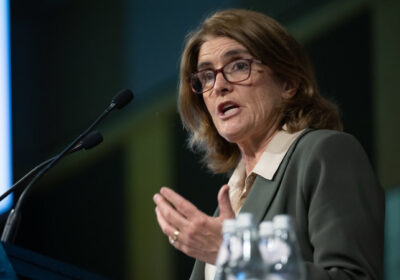House prices back sky high as RBA governor warns of more rate pain to come

Save articles for later
Add articles to your saved list and come back to them any time.
Reserve Bank governor Michele Bullock has put home buyers and businesses on notice that further interest rate pain is on the way, saying inflation is homegrown and being pushed up by strong demand for everything from haircuts to dentistry.
As new figures showed the nation’s housing market had erased the drop in values suffered as the Reserve Bank first started tightening monetary policy last year, Bullock used a major address to the nation’s business economists to argue that despite signs some households were struggling to make ends meet the RBA would continue to use the “blunt tool” of interest rates to bring inflation down.
Reserve Bank governor Michele Bullock warns demand for haircuts, dentists and dining out is keeping inflation high. Credit: Wolter Peeters
She warned that the growing prices of services, such as haircuts, were a substantial concern as they were being supported by strong demand.
“Hairdressers and dentists, dining out, sporting and other recreational activities – the prices of all these services are rising strongly. This reflects domestic economic conditions and is an indication that aggregate demand is sufficiently greater than aggregate supply to sustain these price increases,” she said.
The bank this month took the official cash rate to a 12-year high of 4.35 per cent. Since starting to tighten monetary policy in May last year, the cumulative impact of its rate rises have increased the repayments on a $600,000 mortgage by $1600 a month.
Bullock, speaking in Sydney, said while supply chain issues had initially pushed up inflation, it was now clear that local demand factors were the driving force behind higher consumer prices.
Signalling further interest rate increases were an option, Bullock said it would take time to deal with the “homegrown and demand-driven” inflation pressures pulsing through the economy.
“It took only three quarters for inflation to fall from 8 per cent to 5.5 per cent as the supply side issues eased, and there is some more to go there. But we expect it to take another two years for inflation to fall that much again and move below 3 per cent,” she said.
“This is because much of the remaining task of bringing inflation back to target will require bringing aggregate demand and aggregate supply into closer alignment.”
Bullock said the prices of two-thirds of the goods and services in Australia’s inflation basket were growing faster than 3 per cent, arguing it was much broader than just petrol, electricity and rents.
Data released this week by the Australia Bureau of Statistics revealed a spike in the number of people putting off visits to their GPs, medical specialists and dentists because of cost of living pressures. Dental service prices in Sydney have climbed by 6.2 per cent over the past year, faster than the overall inflation rate of 5.4 per cent.
Inflation nationally for hairdressing services is also running faster than overall inflation at 6.7 per cent. It has been stuck above 6 per cent for the past year, the highest level since the introduction of the GST in 2000.
Bullock admitted she was receiving letters from Australians struggling with cost of living pressures, with low-income households suffering the most at present.
But she held out little hope the bank would reverse its policy settings any time soon.
“While the (bank) board recognises there is a wide diversity of experience, the bank’s statutory objectives are economy-wide outcomes, and our key tool – the interest rate – is a blunt one. The board must therefore set its policy to serve the welfare of Australians collectively,” she said.
Cut through the noise of federal politics with news, views and expert analysis. Subscribers can sign up to our weekly Inside Politics newsletter.
Most Viewed in Politics
From our partners
Source: Read Full Article
